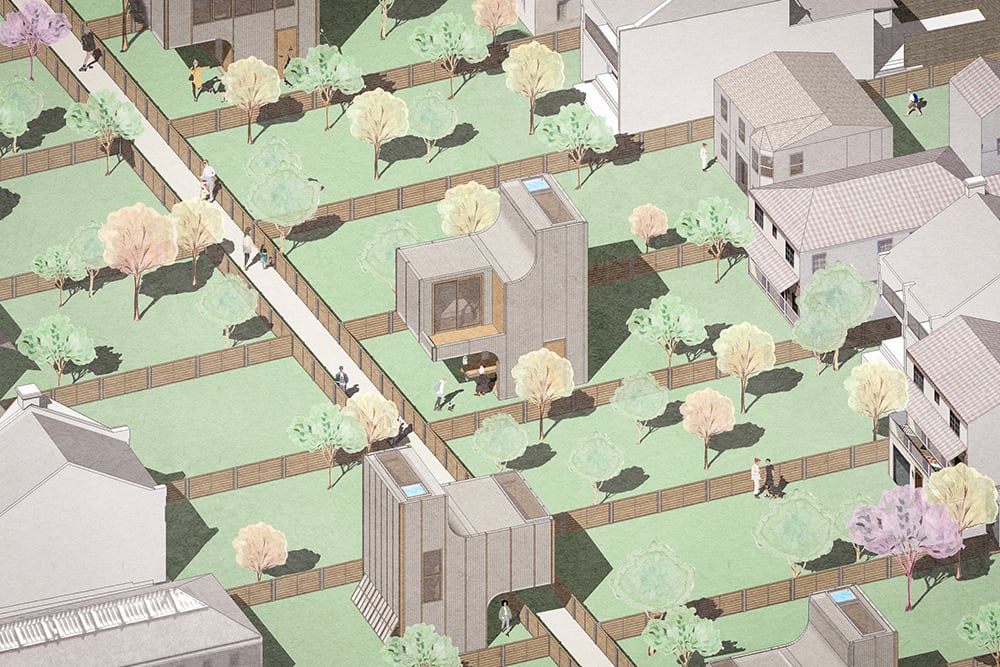Back Lands (Proposed creative solutions to San Francisco’s housing crisis)

In the “Imagine Housing” series of articles, we pose creative solutions to San Francisco’s housing crisis – increasing city density without compromising on character. In this edition we take a look over the fence, into suburban backyards and parking lots.
- Words By
- Dane Bunton
- Date
- 08.20.2020
- Images By
- Studio BANAA
San Francisco, it’s time to dream small.
It was the suburban Californian dream: a big backyard that’s only a short hop from the city or the Bay. And it literally shaped the layout of the San Franciscan suburbs. But in recent times, this low-density dream has given rise to a housing nightmare. To accommodate our ever-increasing population, we need to ensure every square foot of land is used to its full potential. At Studio BANAA, we’ve been looking into suburban backyards to dream up a community-wide solution to a community-wide crisis.
As part of the MINI Living Competition, we’re challenging ourselves to imagine what San Francisco housing will look like 100 years from now. In our vision of our future city, the big-backyard dream is a distant memory. (R.I.P.) Instead, we’re exploring how a government buyback scheme (it’s called ‘Eminent Domain’ – but more on that shortly) can help us reclaim some of this underutilized land to develop into something new. Think: vibrant “mini-villages” where local cafés and retail pockets meet affordable residential in leafy suburbs, and you begin to share our tiny dream.
Property development and community development can be mutually beneficial.
Increased density not only brings the obvious advantages of affordable housing and increased community wellbeing. It also brings improved economic output and, ultimately, rising property values. Whether you’re one of the newly housed, a property owner, developer, or a city planner, the benefits of density can be shared – village by village.
For this higher-density suburban vision to succeed, we must collectively overcome one psychological stumbling block: eminent domain. Our mini-villages concept hinges on local government “borrowing” land from private landholders (who are fully compensated) for community use. Despite successful programs overseas, this idea does not sit well with a lot of Americans, especially some of those who own the land in question. We believe that by demonstrating the personal benefits to property owners – added value, passive income, and increased development opportunities – the prospect of government involvement can act as incentive, rather than deterrent.

A four-step process to mini village development:
- Identify existing residential lots with a backyard
Examples here include Sunset or Richmond districts, where you find large parts of the city footprint with minimum density. These are back-to-back blocks with at least 20 percent rear setback requirements. - Create access
This is where Eminent Domain comes into play. The city pays market value to landholders for a 5-foot-wide strip of land from each back-to-back block – creating networks of narrow streets and walkways. - Get permits
Now the access is in place, it’s up to property owners to decide if they want to build up to two housing units, with at least one of these classified as “affordable.” For those who do take up the opportunity, the government helps out with a streamlined, fee-free permit system to reduce timeframes and cut out red tape. - Build
Time for some basic math here: take a typical suburban backyard of 250 square feet – roughly 25’ x 10’. Subtract the 5-foot access portion and you’re left with 200 square feet. If you keep half of that for your outdoor space, you’re left with 100 square feet to build on. Whether you build two units in a stack, a single home with a rooftop garden, a mixture of ground-floor commercial and upper living, or nothing at all is entirely up to the individual.
New modes of living require new modes of thinking.
Like every bold idea in our “Imagine Housing” series, the success of mini villages requires a community-wide shift in how we look at our housing and suburbs. For property owners this means open-mindedness to selling and/or developing small portions of land for a greater community good. For local governments it means an incremental yet substantial change in legislation to support such a scheme. And for the broader community it requires the imagination to conceive of a post-housing crisis San Francisco.
When we imagine our future city, we envisage a world of opportunity more equitably shared. New passive income streams for landholders. New networks of mixed-use laneways, and pathways to hidden culinary and retail gems. New faces, conversations, connections. New ways to experience all the old things that make San Francisco the place to be. And, above all, we see plenty of new affordable housing for all San Franciscans.